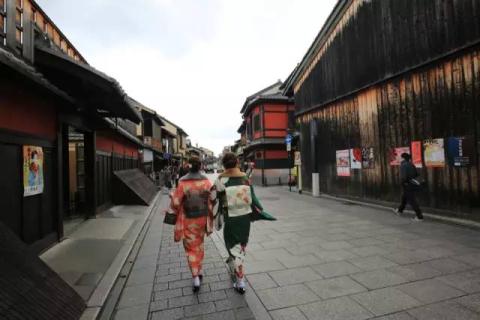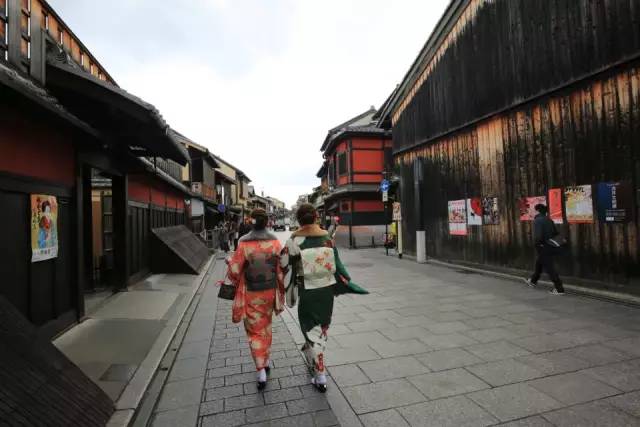
Geisha is a unique culture in Japan. The world of Japanese geisha has always been mysterious. Their profession is called "The World of Flowers and Willows". Most of the female geishas who work in the geisha industry are beautiful, have gorgeous costumes, and are especially good at singing and dancing. Their main job is to accompany guests to drink and have fun. The geisha industry is a performing art, not a show of sex, let alone selling one's body. However, it contains elements of male pleasure and female pleasure, so it is called geisha. What makes geisha elegant and elegant is not only that it is different from prostitutes, but also that it is not excessive. It is difficult for strangers to get involved. Most of them are recommended by acquaintances or celebrities. Geishas mostly entertain guests in geishas, but sometimes they are invited to accompany guests in teahouses and restaurants. According to industry regulations, geishas are not allowed to get married during their career. Otherwise, they must retire first to maintain the "pure" image of geishas.
Geisha (げいぎ, Geigi) was born in Tokyo and Osaka in the 17th century. The original geisha were all men who made a living by playing traditional drums and rapping for fun in brothels and entertainment venues. Around 1750 , the first female geisha appeared. 18In the middle of the century, the profession of geisha was gradually replaced by women, and this tradition continues to this day.
Geisha are called "踸者 (げいしゃ, Geisha)" in Tokyo and other Kanto areas, and they are called "Hanyu" during the apprenticeship stage; in Kyoto, Osaka and other Kanto areas In the western region, it is called "踸鬼(げいこ, Geiko)", and in the apprenticeship stage, it is called "Maiko (まいこ, Maiko)". After the Meiji period, "Yun prostitute" gradually became the modern standard Japanese pronunciation. The word 踸之(げいしゃ, Geisha) is composed of two Japanese characters. "踸(gei)" means "art", and "geisha" means " person" or "actor". The most literal translation of geisha is "artist", "performing artist". In modern Chinese, the word "prostitute" is often intuitively related to the sex trade, so there is a modern Chinese translation of "geisha" for the purpose of avoiding taboos. "Geisha" in Japanese refers to male performers, such as kabuki, so some people argue that "geisha" is the correct Chinese translation to show the difference.
In the 1920s, there were as many as 80,000 geishas in Japan. However, by the beginning of the 21st the number had dropped to one or two thousand, and almost all of them were limited to Tokyo and Kyoto, with only geisha customers. The richest businessmen and the most powerful politicians. Ordinary businessmen are now looking for female bar owners who, although they have no traditional training in singing or dancing, are as considerate and eloquent as geishas. 
White makeup, exquisite kimono and Shimada hairstyle are the most popular characteristics of geisha. A woman who enters the geisha circle must start as a maiko. If she has the opportunity, she can start her career as a geisha. However, no matter which path you take, becoming a maiko or geisha requires a year of training. Whether as a maiko or a geisha, women over the age of 21 are generally considered too old. However, those maiko who succeed on stage enjoy greater prestige later in their careers.
Geishas in the traditional sense were not regarded as obscene in the past. On the contrary, many families were proud that their daughters could enter the art world. Because this not only shows that the family has high cultural quality, but also has enough funds for their daughter to learn skills. Although this concept is not common today, geisha is still good in people's minds. In fact, it is not easy to be a geisha. Learning arts generally starts at the age of 10, and requires five years to complete courses ranging from culture, etiquette, language, decoration, poetry and calligraphy, harp, bowing, and pouring wine. It is very arduous. From the age of 16, you can go to sea, first as a "maiko", and then as a geisha, and you can continue to work until the age of 30. No matter how old you are, you can still continue to work, but you will be demoted and can only serve as a foil to the young and famous geisha. As for the future after old age, most people are not very optimistic. The more ideal thing is to marry a rich man and live a stable life, but this is rare. Some people use their skills to set up art schools or art classes, which is also very good. If you have the opportunity to join a company as an image lady, even though you are just a "vase", you can still show your former style. Of course, there are also many people who become servants or even end up in brothels, which is very unfortunate.
As times change, similar precepts in Japan no longer exist. Due to the strict training and hard life of geisha, coupled with the fact that they are mainly engaged in the service industry to please men, this industry has become a sunset industry, and the number of people is getting smaller and smaller.
There is a lot of investment in cultivating a geisha, but once she becomes famous, the price is also very high. Especially young and beautiful senior geishas are worth more, and ordinary people dare not care about them, but wealthy businessmen, wealthy young people, and large companies do. No expense spared. When the economy is booming, large companies always use geisha as a public relations tool to attract business.
Recently, there has been a craze among teenage girls in Japan who want to become geishas. The Hollywood blockbuster "Memoirs of a Geisha" has obviously played a role in fueling the trend. Despite this, the prototype of "Sayuri" in the movie "Memoirs of a Geisha" - Japan's most famous and richest geisha Mineko Iwasaki angrily criticized the movie and the novel for tampering with the facts, and wrote "Memoirs of a Real Geisha" herself. I haven't read this movie or the book, so I won't comment on them.

Kyoto's Geisha Street Gion, to get to Geisha Street from the parking lot, first Passing through Yasaka Shrine, feeling The shrine covers a large area and has a park attached with many tall trees. In one corner, there is also a small clam shrine. Yasaka In front of the main hall of the shrine, there is a large pavilion with three circles of white lanterns hanging on it. There are few people in the shrine. The atmosphere is quiet and beautiful. I think it must be beautiful at night when the lanterns are lit. , under the night, will More comfortable and more relaxing.
“ Gion ” The origin of this name is the abbreviation of the Buddhist "Jetavana Grove". Jetavana Grove: the tree of Prince Jeta and the courtyard of Elder Anathapindika, so "je" is pronounced as qí. Yasaka Shrine enshrines the Japanese god Susanoo Naruto. "Susanoo" was later merged with the Bull-Headed Deva, the guardian of the Buddhist "Gion-no-She" into one god, so Yasaka Shrine is also known as "Gion-Sha". Over time, the block in front of Yasaka Shrine was named "Gion".
Gion is home to the most famous geisha in modern Japan The "Flower Street" is divided into two parts: Gion East and Gion Kobu. from The Edo Shogunate allowed teahouses to operate here, and it has a history of more than 300 years. In the early 19th century, when it was at its peak, there were more than 3,000 geishas in Gion. Many of the buildings of the geisha houses and teahouses in Gion are still preserved today. 1999 It was designated as a historic landscape protection area by the Japanese government.
The representative building of Gion is the Gion Song and Dance Theater, which is a song and dance theater jointly funded by the geisha house. Every April, geishas perform here. "Kyoto Dance" shows the elegance of geishas and the Japanese classical singing and dancing art. 83 A teahouse with geishas and maikos 120 people. During the day, you can find 7 Many tourists like to relax and have fun in the restaurants and teahouses of the 19th century. When you walk on the road, you can also see geishas in a hurry, and they may pass by you. Yang Zi said that if you can meet a geisha, you will be rich, especially the high-level geishas, who are now national treasures and almost no one can see them.
Crossing the street from the gate of Yasaka Shrine, the sky is very cloudy and a bit depressing. There were not many people on the street and it felt a bit empty. In recent years, there has been a trend of "eliminating Chinese characters" in Japan and South Korea. What I didn't expect was that before arriving at Geisha Street, there was a "Kanji Museum", but time did not permit and I didn't go in to visit it. In fact, in China, "alphabetization" once had a large market, but fortunately it has not been realized. Otherwise, how can we appreciate those beautiful chapters in ancient Chinese, including Japan and South Korea, those beautiful chapters in ancient books, and even historical records, cannot Completely inherited. 
Many of the houses on Geisha Street are 1-2-story wooden structures. Many of the wooden boards have turned black, and the floors are thick granite. The streets were clean, with few pedestrians, and all the art galleries were hung with lanterns and plaques. But I suddenly lost any interest in it. The "Flower Path" that many people on the Internet talked about, haha, is here. 
I walked around easily and saw posters advertising geisha performances in many places. I got closer with my daughter and took a closer look. As expected, many of the "beautiful" geishas were male. , of course, there are also many women. The most vivid time here should be at night. Every night, there will be lanterns here emitting a faint light. You can see the lights emitting a soft light behind the paper windows, the neat wooden clogs at the door, and even You can also see intern geishas working in a hurry, and you can hear the beautiful music. 
It is impossible to see the night of Geisha Street, because we have to rush to our accommodation tonight, Inazawa, Nagoya, and head to Shirakawago tomorrow. For me, I would rather visit Honnoji Temple and Mount Hiei:
In 1571, Oda Nobunaga, the daimyo of Kinki who set out to spread military power over the world, broke up the power of the 15th Muromachi Shogunate in order to consolidate his power in the territory. The Nobunaga siege established by General Ashikaga Yoshiaki was also intended to kill chickens and monkeys and avenge important ministers, relatives and friends. He attacked Enryaku Temple on Mount Hiei, which was regarded as a Buddhist holy place at the time, and set fire to the temple, killing thousands of monks and women. From then on, Start the operation to Luo. On June 21, 1582, when Oda Nobunaga had unified the Kinki region and the "Tenkabu" war to unify Japan was about to be completed, his capable subordinate Mitsuhide Akechi rebelled in Honnoji Temple in Kyoto. Killing him, Toyotomi Hideyoshi replaced Oda Nobunaga, became the center of Japanese power, and finally unified Japan. The Honnoji Incident was the largest and most famous coup in Japanese history, and Japanese history was rewritten.
The setting sun is like blood, and we rush forward again. 
